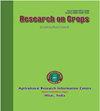Impact of terminal heat stress on performance of Nepalese wheat (Triticum aestivum L.) genotypes
Q3 Agricultural and Biological Sciences
引用次数: 0
Abstract
Heat stress has been a major abiotic stress that has been a key factor for poor production and the productivity of wheat. To understand the impact of heat stress and to evaluate the performance and stability of elite wheat genotypes under irrigated and heat stress environment, a field experiment was conducted under Alpha lattice design at the Institute of Agriculture and Animal Science, Bhairahawa, Rupandehi, Nepal from 2019-2023 comprising 20 elite wheat genotypes collected from Nepal Agriculture Research Council. The combined analysis of variance showed, heat stress had the significant impact on all the traits evaluated with a 29% yield reduction under heat stress condition as compared to irrigated. NL 1368 (21.5%) and NL 1386 (41.4%) had the least and highest yield reduction under heat stress environment as compared to irrigated. BL 4919 was the highest yielding wheat genotype under both irrigated (4287.9 kg/ha) and heat stress environment (2905.4 kg/ha). WWW model revealed, NL 1387 was the most stable wheat genotypes while BL 4919 and NL 1350 were the most adaptable genotypes under irrigated and heat stress environment. Hence, these selected adaptive and stable genotypes should be promoted in the wheat improvement program as a parent material for heat stress breeding.终期热胁迫对尼泊尔小麦(Triticum aestivum L.)基因型表现的影响
热胁迫是一种主要的非生物胁迫,是导致小麦产量和生产率低下的关键因素。为了了解热胁迫的影响,并评估精英小麦基因型在灌溉和热胁迫环境下的表现和稳定性,2019-2023 年,在尼泊尔鲁班德希 Bhairahawa 农业和动物科学研究所进行了阿尔法网格设计的田间试验,包括从尼泊尔农业研究委员会收集的 20 个精英小麦基因型。综合方差分析显示,热胁迫对所有评估性状都有显著影响,与灌溉相比,热胁迫条件下减产 29%。与灌溉相比,NL 1368(21.5%)和 NL 1386(41.4%)在热胁迫环境下的减产幅度最小和最高。BL 4919 在灌溉(4287.9 千克/公顷)和热胁迫环境(2905.4 千克/公顷)下都是产量最高的小麦基因型。WWW 模型显示,NL 1387 是最稳定的小麦基因型,而 BL 4919 和 NL 1350 则是在灌溉和热胁迫环境下适应性最强的基因型。因此,应在小麦改良计划中推广这些适应性强且稳定的基因型,作为热胁迫育种的亲本材料。
本文章由计算机程序翻译,如有差异,请以英文原文为准。
求助全文
约1分钟内获得全文
求助全文
来源期刊

Research on Crops
Agricultural and Biological Sciences-Soil Science
CiteScore
1.50
自引率
0.00%
发文量
93
审稿时长
1 months
期刊介绍:
The Research on Crops is a peer-reviewed journal publishing original research papers, review articles and short communications in English on all basic and applied aspects of crop sciences, agricultural water management, agro-climatology, agroforestry, agronomy, crop production, crop protection, cropping systems, food science & technology, genetics & plant breeding, horticulture, plant & soil science, plant biotechnology, plant nutrition, post-harvest management of crops, seed science, soil management & tillage, vegetables, weed science, agricultural engineering, agri-business, agricultural economics and extension, etc. The aim of the journal is to provide a forum for the scientific community to publish their latest research findings.
The manuscripts submitted for publication should not contain data older than 4 years on the date of submission.
The articles submitted for publication in this journal should not be submitted elsewhere simultaneously for publication in another journal. These should not carry any copyright material without prior permission of copyright holder.
The articles should present a complete picture of the investigation made and should not be split into parts.
There is no prescribed limit regarding the number of pages in case of full-length articles. However, the authors are advised to keep the length of their articles from 4 to 10 full printed pages of the journal.
The articles should be divided into the sub-sections: ABSTRACT, INTRODUCTION, MATERIALS AND METHODS, RESULTS AND DISCUSSION, CONCLUSIONS, and REFERENCES. Tables and figures should be appended separately at the end.
 求助内容:
求助内容: 应助结果提醒方式:
应助结果提醒方式:


